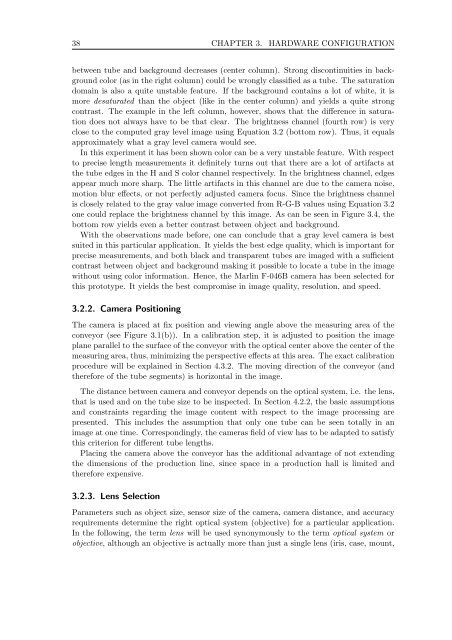Master Thesis - Fachbereich Informatik
Master Thesis - Fachbereich Informatik
Master Thesis - Fachbereich Informatik
You also want an ePaper? Increase the reach of your titles
YUMPU automatically turns print PDFs into web optimized ePapers that Google loves.
38 CHAPTER 3. HARDWARE CONFIGURATION<br />
between tube and background decreases (center column). Strong discontinuities in background<br />
color (as in the right column) could be wrongly classified as a tube. The saturation<br />
domain is also a quite unstable feature. If the background contains a lot of white, it is<br />
more desaturated than the object (like in the center column) and yields a quite strong<br />
contrast. The example in the left column, however, shows that the difference in saturation<br />
does not always have to be that clear. The brightness channel (fourth row) is very<br />
close to the computed gray level image using Equation 3.2 (bottom row). Thus, it equals<br />
approximately what a gray level camera would see.<br />
In this experiment it has been shown color can be a very unstable feature. With respect<br />
to precise length measurements it definitely turns out that there are a lot of artifacts at<br />
the tube edges in the H and S color channel respectively. In the brightness channel, edges<br />
appear much more sharp. The little artifacts in this channel are due to the camera noise,<br />
motion blur effects, or not perfectly adjusted camera focus. Since the brightness channel<br />
is closely related to the gray value image converted from R-G-B values using Equation 3.2<br />
one could replace the brightness channel by this image. As can be seen in Figure 3.4, the<br />
bottom row yields even a better contrast between object and background.<br />
With the observations made before, one can conclude that a gray level camera is best<br />
suited in this particular application. It yields the best edge quality, which is important for<br />
precise measurements, and both black and transparent tubes are imaged with a sufficient<br />
contrast between object and background making it possible to locate a tube in the image<br />
without using color information. Hence, the Marlin F-046B camera has been selected for<br />
this prototype. It yields the best compromise in image quality, resolution, and speed.<br />
3.2.2. Camera Positioning<br />
The camera is placed at fix position and viewing angle above the measuring area of the<br />
conveyor (see Figure 3.1(b)). In a calibration step, it is adjusted to position the image<br />
plane parallel to the surface of the conveyor with the optical center above the center of the<br />
measuring area, thus, minimizing the perspective effects at this area. The exact calibration<br />
procedure will be explained in Section 4.3.2. The moving direction of the conveyor (and<br />
therefore of the tube segments) is horizontal in the image.<br />
The distance between camera and conveyor depends on the optical system, i.e. the lens,<br />
that is used and on the tube size to be inspected. In Section 4.2.2, the basic assumptions<br />
and constraints regarding the image content with respect to the image processing are<br />
presented. This includes the assumption that only one tube can be seen totally in an<br />
image at one time. Correspondingly, the cameras field of view has to be adapted to satisfy<br />
this criterion for different tube lengths.<br />
Placing the camera above the conveyor has the additional advantage of not extending<br />
the dimensions of the production line, since space in a production hall is limited and<br />
therefore expensive.<br />
3.2.3. Lens Selection<br />
Parameters such as object size, sensor size of the camera, camera distance, and accuracy<br />
requirements determine the right optical system (objective) for a particular application.<br />
In the following, the term lens will be used synonymously to the term optical system or<br />
objective, although an objective is actually more than just a single lens (iris, case, mount,














